The defeat of the Turkish army in the battle of Kainly
Preparing for the 1829 campaign of the year
The 1828 campaign of the year for the Separate Caucasus Corps under the command of Ivan Fyodorovich Paskevich was victorious. Russian troops defeated the enemy, captured several important fortresses and castles. Thus, in June, the Russian army took the first-class fortress of Kars, in July - Akhalkalaki, in August - Akhaltsikhe, Atskhur and Ardahan. Separate Russian detachments took Poti, Bayazet and Diadin. Chavchavadze detachment occupied the Bayazet pashalyk.
In Russia, the public enthusiastically perceived the success of the Russian army in the Caucasus. The warriors of the Caucasian corps were compared with the wonder-heroes of Alexander Suvorov. Paskevich became the hero of the war 1828 - 1829. The onset of winter, which is very harsh and unpredictable in the mountains, stopped the fighting. In the occupied territories and in the fortresses, 15 battalions, 4 Cossack regiments and 3 artillery companies were left to protect them. The remaining troops were withdrawn to their territory.
Both sides were actively preparing for the 1829 campaign of the year. The successes of the Russians in the Caucasus caused anger in Constantinople. The command of the Turkish army in the Caucasus changed. Erzerumsky Ghalib Pasha and seraskir (commander-in-chief) Kios-Magomed Pasha lost their posts and were sent into exile. The new commander-in-chief was appointed Haji-Saleh Meydansky, he was given unlimited powers. Active troops led by Gakki Pasha. They received a lot of power and funds, they had to mobilize in the border areas, assemble a large army and recapture the pashalyks captured by the Russians. Then the Ottomans planned to move the hostilities in the Russian Transcaucasus — Guria, Kartli, Mingrelia and Imeretia. Turks were going to return the previously lost territory in the South Caucasus. Ahmad Bey of Adjara, the largest feudal lord in Akhaltsykh pashalyk, was preparing a separate attack on Akhaltsikh.
The Russian command was also actively preparing for the continuation of hostilities. 20 Thousands of Recruits were supposed to replenish the Caucasian Corps. However, they were supposed to arrive only in the spring, it took time for their training. Therefore, the campaign had to start cash. The Russian commander Paskevich planned to attack on the main, Erzurum direction, take the key enemy enemy base-Erzerum, and then go to Sivas in Central Anatolia. With such a blow, the Russian Asian possessions of Turkey in half, intercepted communication to Baghdad.
In order to strengthen the Separate Caucasian Corps, by order of the governor, the hunters (the volunteers were then called) formed 4 Muslim regiments (500 riders), two Armenian semi-battalions in Erivan and Nakhichevan, one battalion in Bayazet. However, the attempt to form the Georgian Zemstvo militia to protect Georgia from a possible invasion of the enemy, in addition to the already existing temporary militia, failed. In Eastern Georgia, a rumor spread that Russians were introducing recruitment duties, people being recruited into soldiers for 25 years. Began unrest. The peasants were ready to go all the way to repel the Ottoman invasion (the memory of the previous horrors of the enemy invasions was still fresh), but they wanted to return to their homes after the end of the war. As a result, the idea of the militia had to be abandoned in order not to cause an uprising in the rear. There remained only a voluntary police (horse and foot), which was recruited from the nobility and their people.
Also, the Russian command conducted secret negotiations with the Kurdish leaders. The Kurds were a warlike tribe and made up a large part of the Turkish irregular cavalry. Part of the Kurdish leaders eagerly switched to the service of Russia. Among them was a musha pasha. He asked to leave the post of the pasha - Governor-General Mush and monetary reward. Pasha promised to put 12 thousand riders. Such an agreement strengthened the position of the Russian army on the left wing.
In the meantime, the situation in the Persian direction was heated. In Tehran, the Persian war party, behind which the British stood, organized unrest, was killed by a Russian mission led by Alexander Griboyedov. There was a threat of a new war with Iran, while the main forces of the Russian army were linked with the hostilities with the Turks. However, the Shah did not want to fight, he remembered well about the crushing defeat of Persia in the 1826-1828 war. The matter was settled with peace. The Persians offered apologies and rich gifts. The Russian government, not wanting a new war in such adverse circumstances, went against the Persians.
In the spring of 1828, Paskevich had 50 thousand soldiers in the Caucasus. Count Erivansky was able to allocate about 17 - 18 thousand men (19 infantry battalions and 8 cavalry and Cossack regiments) to the operating corps with 70 guns. The rest of the forces were linked by the defense of Georgia, the Black Sea coast, the Persian border, and were garrisons on the Caucasian line.
Turkish offensive. Akhaltsikha Defense
The first to start the offensive was the Turkish army. The Ottomans attacked on their left flank. Ahmad Bey with 20 Thousands of troops (5 Thousands of regular infantry and 15 Thousands of militia) February 20 1829, the mountain passes went to Akhaltsikh (Akhaltsykh) and laid siege to the fortress. The Russian garrison of the fortress numbered only 1164 people with 3 serf guns and 6 field guns. The Russian detachment was commanded by Major General Vasily Osipovich Bebutov. It was an experienced commander who fought with the Turks, mountaineers and French. In the 1828 campaign of the year he distinguished himself in the Akhaltsikhe battle and the storming of Ahyltsikha, and was appointed chief of the Akhaltsykh pashalyk.
The Turkish commander immediately left the troops for an assault, hoping for a surprise attack and overwhelming numerical superiority. However, the small Russian garrison bravely met the enemy and repulsed the attack with rifle fire, pre-prepared stones, grenades and bombs. After the assault failed, the Turks began to besiege the fortress. The siege lasted 12 days. The position of the Russian garrison, despite the successful reflection of the assault, was difficult. The Turks fired at the fortress and tried to deprive it of water. Ahmed-bek covered himself from the Borzhomi gorge with a barrier and the Russian command did not immediately know about the enemy attack.
After the Russian detachment under the command of Burtsev, who was able to bypass the Turkish barriers, came to the aid of the Akhaltsikhe garrison, Bebutov's garrison made a successful raid. The Turks lifted the siege and fled, losing 2 flags and 2 guns. Russian troops pursued the enemy troops, which were defeated and scattered. Russian losses during the siege were 100 people. The Ottomans lost about 4 thousand people.
At the same time, the attack of the 8 ths. Detachment of the Trapezes pasha, which was supposed to support the uprising in Guria, failed. The Turks had high hopes for this uprising. The Ottomans were defeated at the end of Limani, near the Nicholas Fortress by a detachment under the command of Major General Hesse.
In mid-May 1829, the Turkish command was preparing to launch an offensive on the main line, on Kars. The Turkish commander-in-chief, Haji Saleh, prepared the 70 thousand army to smash the Russians and fight off Kars. At the same time, the Turks were preparing auxiliary blows on the flanks. On the left wing of Trabzon the Pasha was to invade Guria again. But Ahmed Bey, recovered from the defeat at Akhaltsikh and was preparing for a new offensive. On the right wing, Van Pasha was supposed to attack Bayazet.
Russian offensive
The Russian commander-in-chief, Paskevich, decided to outstrip the enemy and be the first to launch an offensive, defeating the enemy army in the Kars-Erzurum direction. The entire 4 battalion, the 1 Cossack regiment and the 12 guns were abandoned to defend the Bayazet pashalyk. The remaining forces were concentrated for a decisive offensive - about 18 thousand people with 70 guns. The headquarters of the Caucasian governor-general moved to Akhalkalaki, then to Ardahan. Russian troops were located on the front from Kars to Akhaltsikha.
Here the Russian commander received new data on the location of the enemy army in the region of the Saganlug mountain range. The advanced Turkish corps under the command of Gakki Pasha (20 thousand people) was located 50 versts from Kars, on the Erzerum road. Behind him were the main forces of Seraskir Haji-Salekh - 30 thousand people. In addition, 15-th. The Ottoman Corps was preparing to attack Akhaltsikh.
The Russian command planned to defeat the enemy in parts — first the Gakka-Pasha corps, and then the Haji-Salekh troops. However, this plan could not be implemented. Bad mountain roads and Turkish barriers prevented the Russians. The Ottomans managed to unite their forces. However, the Turkish plan of attack on Akhaltsik failed. The Turks could not crush separately the detachments of Burtsev and Muravyov. Russian troops managed to unite and 2 June 1829 of the year in a battle near the village of Chaboria on the bank of the Prokhov River broke superior Turkish forces aimed at Akhaltsikh. Akhaltsikha fortress was now safe and strengthened by one battalion. After that, the troops of Burtsev and Muravyov pulled up to the main forces.
Battle of Kainly
The battle near the village of Kainly 19 June (1 July) 1829 of the year was one of the largest in this war. Paskevich-Erivansky divided the troops into three columns. The first (main) convoy (5,3 thousand soldiers with 20 guns) was commanded by Muravyov. The troops were located on the right flank, north of the river Zagin-Kala-su. On the left flank the column (1,1 thousand people with 12 guns) was commanded by Major General Burtsev. It was located south of the river. Behind the main column there was a strong reserve under the command of Major General Rayevsky (3,5 thousand people with 20 guns). The rest of the troops under the command of General Pankratiev remained in the camp, located on the mountain Chakhar-baba. Troops were built by 13 hours.
At about 14 hours, the Turkish cavalry, which occupied both parallel roads leading to Erzerum, attacked Muravyov’s convoy. To defeat the enemy, the Russian general used tactics that already showed themselves well. The Russian cavalry counterattacked the enemy, then quickly withdrew, imitating the flight, the Turks, inspired by the seeming victory, rushed forward and fell under carter fire. The Turks suffered heavy losses and retreated. Seeing the futility of attacks on his left flank, Haji Saleh ordered the attack on the weaker Burtsev column. 6 thous. Horsemen of Gakki-pasha were thrown on the offensive. The Ottoman cavalry broke through the line of Russian archers, walked around the square and entered the rear of the Russian column. Burtsev used artillery to repel the attack. In addition, he was sent to the aid of part of the reserve and light artillery. The Turks and on the right wing did not succeed, suffered heavy losses and regressed.
After repelling the attacks of the Ottoman army, the Russian troops themselves went on the offensive. The main blow was dealt to the central position of the enemy. The strong fire of the Russian artillery and the strike of the Russian infantry led to the rupture of the Turkish line. To secure success, the Russian commander breached the Georgian Grenadier Regiment with 8 guns. As a result, the troops of Gakki-pasha and Haji-Salekh were separated from each other. The seraskira troops were driven back across the Kainlykh River, and the Gakki Pasha to their camp in the Khan gorge.
Initially, Paskevich was going to put the tired troops to rest and continue the battle the next day. However, there was a threat that the Ottomans would strengthen in the new position, which would complicate the continuation of the battle. Also, there were reports that the Turks are waiting for a strong reinforcement. Therefore, Paskevich-Erivansky decided to continue the fight. Against the troops of Gakki Pasha, a barrier was put under the command of Burtsev - 2 infantry and 1 equestrian regiments with 20 guns. The main forces opposed seraskira. Russian troops were again divided into three columns. The right column was commanded by Muravyov, the central - by Rajevsky, the left - by Pankratiev.
The new offensive began at 8 in the evening. For the Ottomans, the new offensive of the enemy was unexpected. The Turks thought there was a lull before dawn. Columns Muravyov and Pankratieva began bypassing the enemy camp. Turkish artillery fired indiscriminately, but there was no sense in it. Russian troops continued the offensive. The Turkish infantry panicked, abandoned the trenches and ran, throwing weapon and various property. Russian troops chased the enemy. Turkish commander barely managed to escape. As a result, Russian troops took about 3 thousand prisoners, 12 guns, all the reserves of the Turkish army. The remnants of the Ottoman troops fled to Erzerum, or simply fled in search of salvation.
20 June (2 July) 1829 of the year in the battle near the village of Miliduz was crushed and the body of Gakki-Pasha. At night, Russian troops made a detour through the mountain road and in the morning went to the rear of the enemy. The Ottomans prepared for battle, they still did not know about the defeat of the main forces of the seraskir. They were informed about this, which caused a stir in the camp and offered to capitulate. Gakki Pasha agreed to lay down arms, but asked for personal safety. Paskevich demanded unconditional surrender. The Turks tried to shoot back, however, as soon as the Russian troops launched an attack, the Ottomans fled. Cossacks and Caucasian police persecuted the enemy, killed many, captured about 1 thousand people. Gakki Pasha was among the captives.
Thus, in the battle 19 - 20 June (1 - 2 July) 1829, the year 50-thousand. the Turkish army suffered a complete defeat, thousands of soldiers were killed, wounded and captured, the rest fled or hid in Erzerum. The Russians captured the entire field artillery of the enemy - 31 gun, 19 banners, all stocks. Russian losses were minimal - 100 people. Turkish plans for revenge and the invasion of the Russian limits were buried.
Defense of Bayazet
Almost at the same time, the Turks were defeated under the walls of Bayazet, on the left flank of the Caucasus Front. 20 June (2 July) - 21 June (3 July) 1829 of the year 14-th. the body of Van pasha stormed Bayazet. He was defended by a small Russian-Armenian garrison under the command of Major General Popov (over 1800 Russian soldiers and Cossacks, about 500 Armenian policemen). For two days a fierce battle was boiling: the enemy was repelled with rifle and artillery fire, they went in bayonet attacks.
As a result, the assault reflected. The Ottomans retreated to distant heights, but remained in the city. During the two-day fierce fighting, Turkish troops lost about 2 thousand people killed and wounded. Russians are more than 400 people, Armenians only killed 90 people, the number of injured is unknown.
Until June 30, the Ottomans besieged Bayazet, carried out separate attacks, disturbed the garrison. After receiving news of the defeat of the serraskir and the fall of Erzerum, Van Pasha lifted the siege and on July 14, 1 (13) withdrew the troops in the direction of Van. After a day, the Bayazet pashalik was cleared of the Turks.
The news of Bayazet’s bloody assault and the critical situation of the Russian garrison was a difficult moment for Paskevich. He received his 23 Jun, after the defeat of the Turkish army. To help Bayazet could send Bekovich-Cherkassky detachment, but this weakened the main forces of the Russian army in the Erzurum direction, where they were still waiting for the continuation of heavy fighting. As a result, Paskevich decided that the defeat of the Turkish army and the fall of Erzerum would already force Van's Pasha to withdraw the troops back. It was the right decision. Thus, the advance of Van Pasha on the Russian left flank did not lead the Ottomans to victory. A small Russian garrison in Bayazet withstood a heavy assault. The troops of Van Pasha could not solve the task of creating a threat to the flank and rear of the main forces of the Russian Caucasus Corps, which could greatly complicate the campaign.
Capture Erzerum. Victory
After the defeat at Kainly, the Turks tried to gain a foothold in the fortress of Gassan-Kale. But the demoralized soldiers did not want to fight and fled on, to Erzerum. Russian troops marched 80 versts for three days and occupied Gassan-Kale, captured 29 guns. The road to Erzurum was open. The Russian command strengthened Gassa-Kale, brought additional trophy guns and various supplies here, making the fortress the base of the Caucasian corps.
Russian troops reached Erzerum - one of the largest cities of the Ottoman Empire. The city was in a panic. His garrison was demoralized by the defeat of the army. Seraskir could not organize the defense of a strong fortress. Under pressure from the council of local elders, who feared the pogrom of the city during the fighting, the Turkish commander in chief 26 June (8 July) 1828 of the year agreed to the unconditional surrender of Erzerum. June 27 (July 9) Russian troops entered the city. The Turkish garrison at the fortified height of Top-Dag tried to resist, but was quickly suppressed.
Thus, the Russian army without a fight took the capital of Anatolia, the rich and crowded Erzerum, the main base of the Turkish army in the Caucasus. Russian got rich trophies: 150 field and serf guns, all the reserves of the Turkish army, including the arsenal of the fortress. The Russians occupied the main control center of Anatolia, destroyed and scattered the Turkish Anatolian army, captured the strategic initiative and got the opportunity to develop the offensive.
The offensive of the plow of Pesa was also unsuccessful. Russian troops captured the Bayburt fortress, in July and September they defeated the enemy two more times. Further hostilities were halted due to the lengthy Russian communications and the insignificance of the forces of the Caucasian Corps for an offensive in such a vast theater of hostilities. 2 (14) September 1829 was signed the World of Adrianople. Russia returned most of the occupied fortresses to Turkey, including Erzerum, Kars and Bayazet. Russia has a section of the Black Sea coast, including Anapa, Sukhum and Poti, the fortresses of Akhalkalaki and Akhaltsikhe. The port recognized the transfer to Russia of Georgia (Kartli-Kakheti, Imereti, Mingrelia and Guria), as well as the Erivan and Nakhichevan khanates, transferred by Persia under the Turkmen Treaty of 1828.
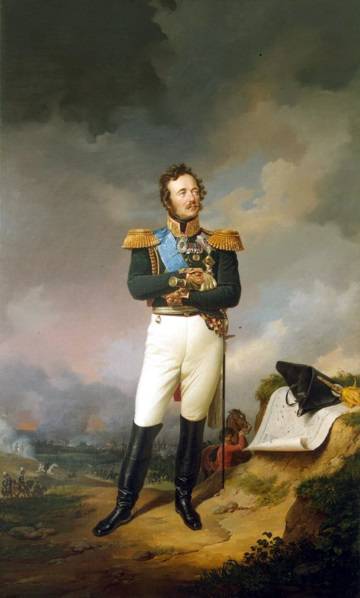
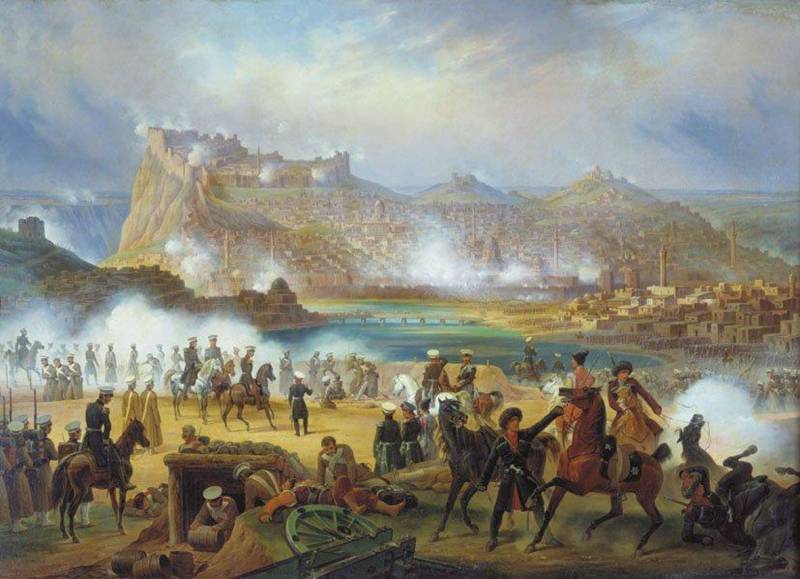
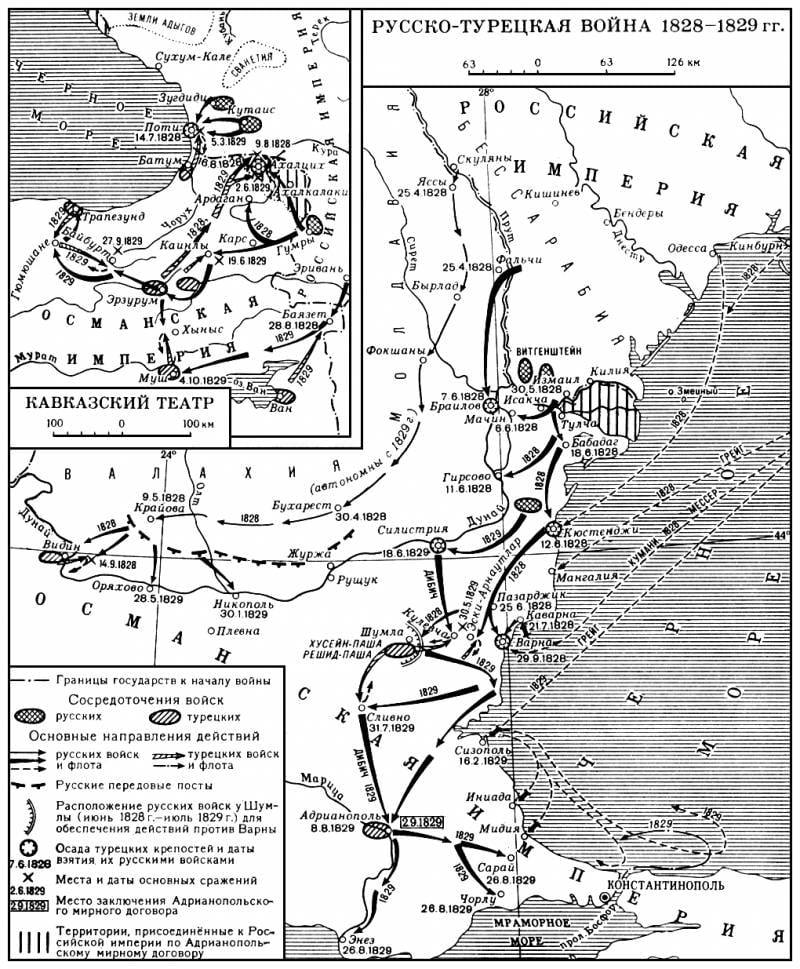
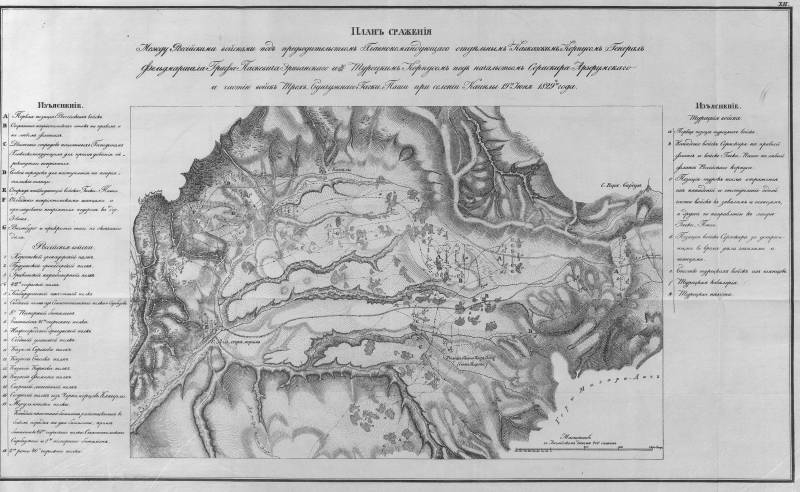
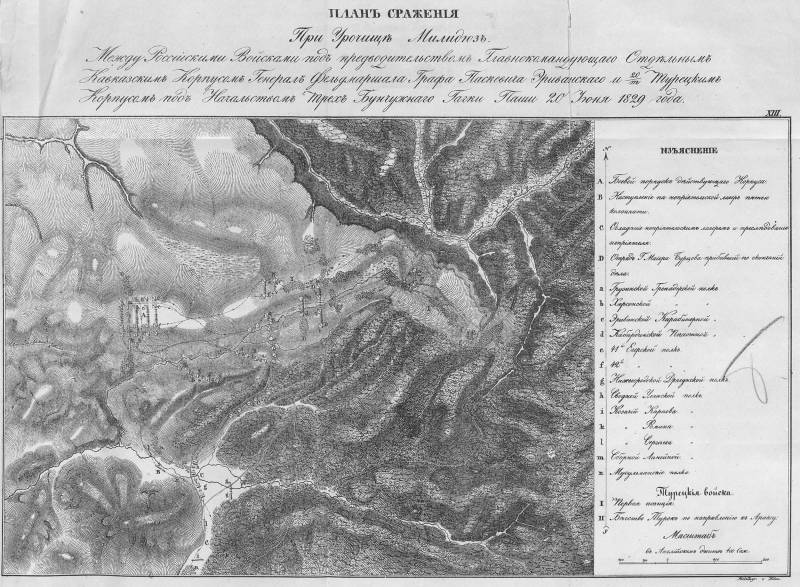
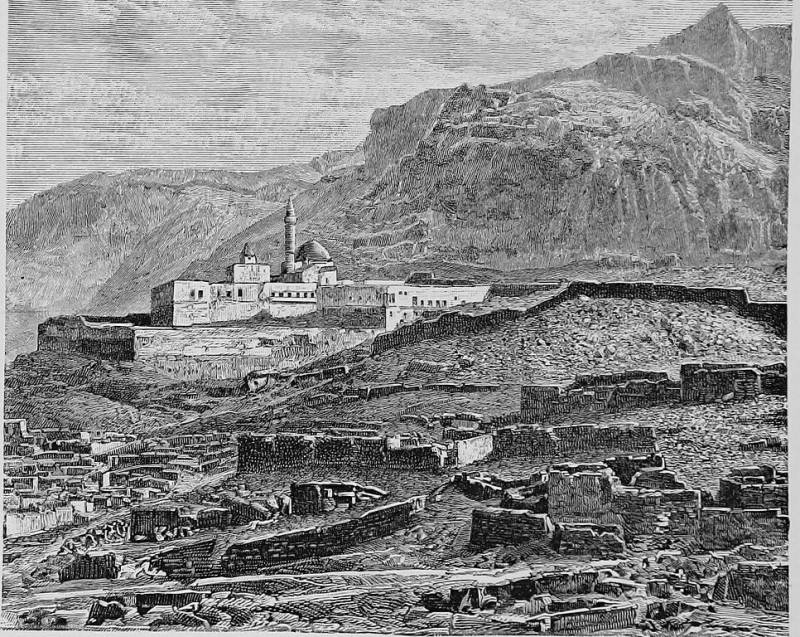
Information